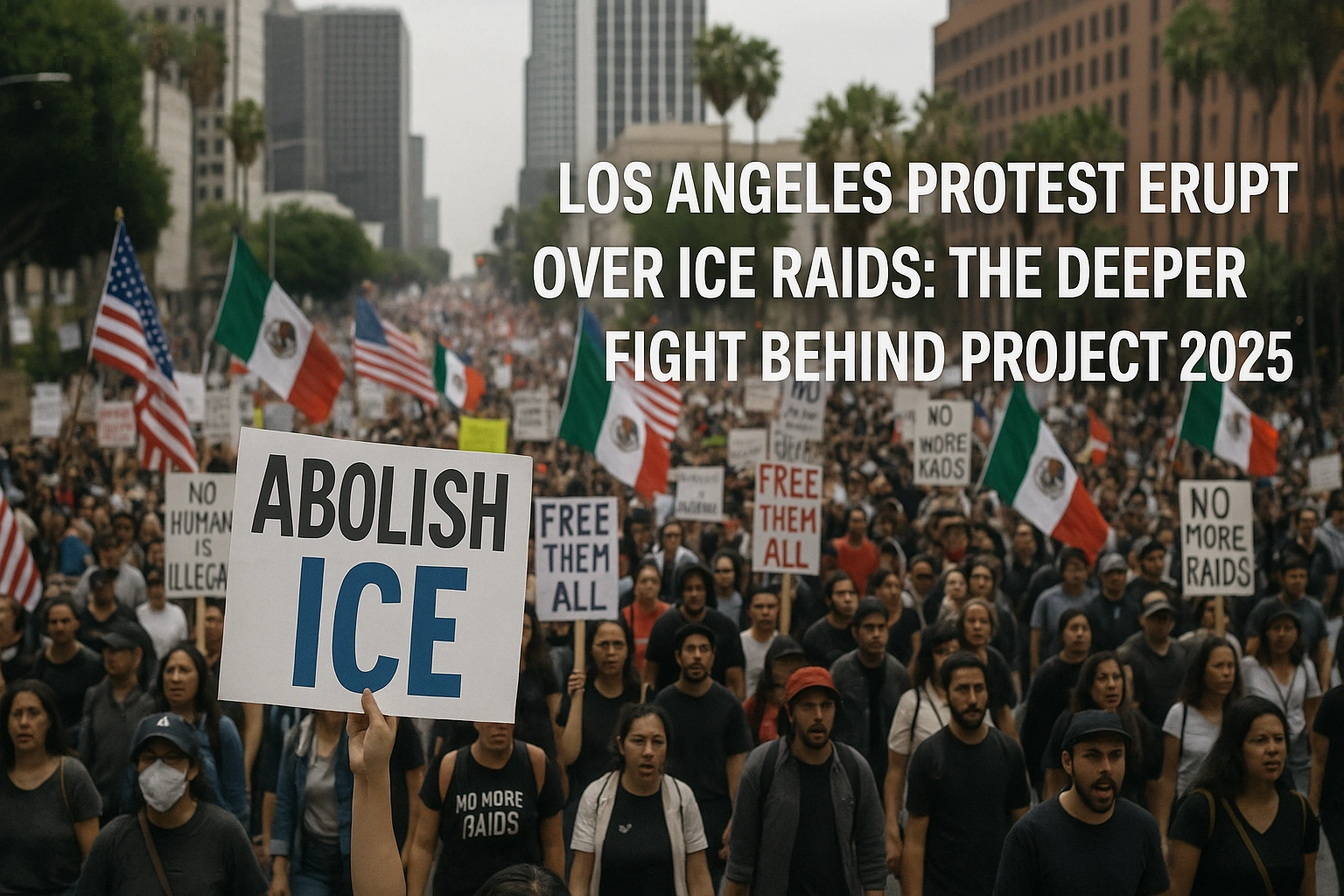Los Angeles, June 2025 — The streets of Los Angeles have once again become the epicenter of national attention. What began as coordinated ICE raids in commercial districts quickly spiraled into citywide protests, drawing in thousands of demonstrators and prompting an aggressive response from both local law enforcement and the federal government. The events offer a microcosm of the political and social tension gripping the United States—one that is inseparable from the broader ambitions of Donald Trump’s “Project 2025.”
From Routine Enforcement to Civil Unrest
The catalyst: large-scale ICE operations in downtown Los Angeles targeting immigrant workers and business owners. Over 100 individuals were detained in a single morning, including documented immigrants and long-time residents. The raids unleashed a wave of outrage, particularly in a city long known for its “sanctuary” policies and deep-rooted immigrant communities.
Within hours, crowds swelled downtown, blocking freeways and gathering in iconic locations across the city. While most protests remained peaceful, sporadic violence broke out, with reports of property damage, physical altercations, and police deploying tear gas and rubber bullets. More than 400 people were arrested over several days, and several journalists sustained injuries in the chaos.
Federal Escalation: Military on American Streets
In a move unseen in decades, President Trump bypassed state authorities and ordered the deployment of over 4,000 National Guard troops and nearly 700 Marines to Los Angeles. The decision was met with fierce opposition from California’s state and city officials, who condemned the use of military force against civilians as a violation of democratic norms and state sovereignty. The images of armed troops on American streets, confronting fellow citizens, have drawn comparisons to some of the darkest moments in recent US history.
Numbers That Tell the Story
- Demonstrators: Estimates place the number of protesters in the thousands, with surges at key sites in the city center.
- Arrests: Over 400 individuals detained by police during the course of the protests.
- Federal Troops: More than 4,000 National Guard and 700 Marines deployed, making it the largest federal intervention in a US city in over a generation.
- Injuries: Multiple journalists and demonstrators suffered injuries, highlighting the risks faced by both citizens and the press.
Symbolism and Resistance
The protests have taken on a distinctly multicultural character, with participants waving Mexican and Central American flags alongside American ones—not as a provocation, but as an assertion of identity and resistance. Local celebrities, community leaders, and politicians have voiced their opposition to the raids, denouncing them as cruel and un-American. The movement has drawn comparisons to the civil rights protests of the 1960s, emphasizing a long tradition of Los Angeles as a center for social change.
The Real Engine: Project 2025
Beneath the immediate crisis lies a far more ambitious and controversial agenda—Project 2025. Developed by conservative think tanks and Trump loyalists, this policy blueprint envisions a radical transformation of the US federal government. The main tenets:
- Centralization of Executive Power: Key agencies—Justice, Homeland Security, Education, and Commerce—would be placed directly under presidential control or dissolved.
- Loyalty-Driven Bureaucracy: Up to 50,000 federal employees could be replaced by politically vetted appointees, removing longstanding protections for civil servants.
- Expanded Use of Federal Force: The plan explicitly outlines pathways for using military force, under the Insurrection Act, against domestic dissent or unrest.
- Welfare Retrenchment: Sweeping cuts are proposed for social programs, including overtime pay, food assistance, Medicare, and Social Security.
In practice, Trump’s administration has moved swiftly to implement many of these policies, reshaping government operations and challenging the foundational checks and balances that have long defined American democracy. Critics argue that Project 2025 is not merely a policy platform but a manifesto for consolidating executive authority and marginalizing political opposition.
A Tipping Point for US Democracy
The standoff in Los Angeles is emblematic of a larger national struggle. On one side: a vision of centralized authority, aggressive enforcement, and top-down order. On the other: a diverse coalition defending civil rights, local autonomy, and the foundational promise of the American republic.
If the principles outlined in Project 2025 continue to advance, the nation could witness a historic rebalancing of power—one that would profoundly alter the relationship between government and governed, and set a precedent for the use of federal force in times of domestic conflict.
Conclusion: Why It Matters
The Los Angeles protests are not just about immigration enforcement. They are about the very soul of American democracy—about who wields power, how it is used, and what limits exist to protect the rights of the people. As Project 2025 moves from proposal to reality, the outcome of this struggle will have consequences not only for Los Angeles or California, but for the entire country—and, by extension, for democracies around the world.








